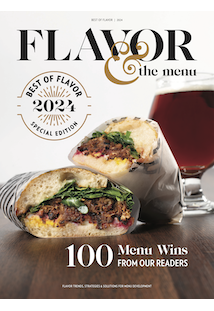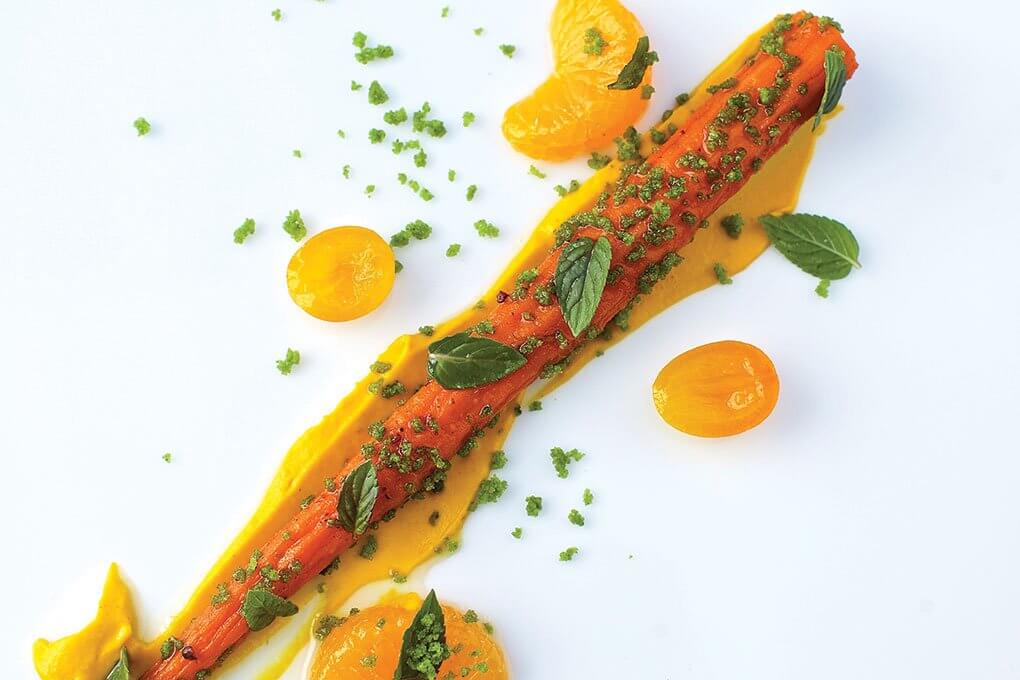Updating the always-popular bruschetta can be a challenge. A new take replaces fresh basil with a sprinkle of forest-green basil flavor crystals. The dish is now modern, colorful and signature.
What about a Caprese salad? Delightful in its classic form, but ready for a close-up with a flourish of balsamic “caviar” and EVOO powder on top.
These are the kinds of innovation we’re seeing on menus, offering a golden opportunity through clever, click-worthy takes on texture.
Gabriel Caliendo, VP of food & beverage at Lazy Dog Restaurants, sees elements like powders, dusts, crystals and pearls as ways to elevate a dish or drink with whimsy and uniqueness in the marketplace. “It gives chefs an opportunity to put an exclamation point on a dish,” he says.
He uses the Bloody Mary as an example. “Everybody has one on the menu. A flavor-forward, fun dust as a rim makes it stand out. How about a Corn Nuts dust rim on a Bacon Bloody? Consumers know that flavor, so it’s not too high-end or exotic, yet it’s different and interesting. That quality is worth a lot today.”
Texture is always an element in recipe builds—it’s one of the pathways to craveability. Today’s opportunity sees a concentration in creativity, flavor and visual appeal. With modern innovation, it’s about upping the game.
“Texture is a key component to flavor, as mouthfeel becomes more a part of how dishes are developed,” says Kathy Casey, chef/founder of Kathy Casey Food Studios – Liquid Kitchen. “Look at very trendy items like boba tea—and now popping boba. It’s all about the texture, the burst and the addition of flavor.”
Popping boba illustrates the trend well. Unlike traditional boba, which is made of tapioca, popping boba is made with the spherification process, infused with a myriad of flavors.
Play Around With Textures – Ideas for textual enhancements to update existing menu items.
Featuring this type of pearl in a cocktail is an example of texture moving further into flavor and whimsy. “Popping boba adds fun and flavor to signature cocktails,” she says. “Think of a tall hand-shaken mojito, now topped with passionfruit bursting boba, or a frozen cocktail like frosé with strawberry popping boba.”
Specialty shops aimed at younger consumers are forging ahead, with places like Bubblz Bubble Tea in Adrian, Mich., serving a variety of popping boba in its teas, from kiwi and strawberry to blueberry and pomegranate—all adding a burst of juicy flavor and color.
This bright, whimsical, lighthearted world of elevated texture can play across the menu—from cocktails and nonalcoholic drinks to bowl builds, veg-centric dishes, entrées and desserts. “Consumers’ desire for fun flavors, entertainment and new experience is helping drive the trend,” says Rob Corliss, chef/founder of All Things Epicurean (ATE). “Culinary innovation always taps into a chef’s passion to create bold, new experiences for guests. Texture has been pushed to the forefront of this exploration.”
 Grove Bay Hospitality Group
Grove Bay Hospitality Group Stubborn Seed in Miami Beach, Fla., adds even more eye appeal with generous use of a flavored dust.
Dusts, Powders & Crystals, Oh My
The casualization of these textural nuances is exciting, opening up so many pathways to creative takes on flavor and texture. GT Prime, a chic steakhouse in Chicago, features porcini dust on its GT Burger, with sun-dried tomato, onion marmalade and cheese.
At Stubborn Seed by Jeremy Ford, a seasonal American restaurant in Miami Beach, Fla., the Desert Daisy cocktail stands out with Olmeca Altos blanco tequila, amaro, lime, beet and orange bell pepper syrup, and a habanero-carrot powder, made with blended chile flakes, dehydrated carrots and salt. “The drink is a modern interpretation of a traditional margarita, but instead of salt on the rim like the classic drink, the spicy ‘salt dust’ creates a colorful texture on the globe-like orb, giving the illusion that it’s suspended in mid-air,” says Ryan Ruiz, general manager.
In today’s competitive landscape, one-upmanship is a genuine strategy. “We’re all trying to stand out, make our offerings just that much better, different, memorable,” says Quinn Adkins, director of menu development for Culver’s. “Small points of differentiation are crucial, and elements like crystals, powders and finishing sugars make that goal easier.”
He describes how a flavor crystal can have deep flavor impact either on a savory or sweet dish. “Think about a cayenne-infused turbinado sugar crystal over a dark-chocolate/espresso cookie,” he says. “You get that visual pop, then you get the cayenne bite enhancing the whole experience. That’s the kind of detail that resonates today.”
Adkins says Culver’s is exploring new products on the market that deliver flavor without sugar. “Now, we can get these really nice flakes that don’t have the sweet component,” he says, “like a Kona coffee flake that has a nice, subtle coffee flavor with no sweetness, making it perfect for a beef roast. This is a game changer because sweet isn’t always desirable.”
Using dusts, powders and crystals helps make menu items showstoppers. “Enhancing flavor with texture is a technique sure to get a guest’s attention,” says Ron DeSantis, principal advisor of CulinaryNXT. “The ingredients needed to make an impact don’t have to be complicated.” He names pork “panko” (made with crispy pork) and puffed grains seasoned with za’atar as two creative pathways to distinction.
 Gabrielle Geiselman Photography
Gabrielle Geiselman Photography Crispy habanero adds crunchy bits of heat to Bywater American Bistro’s Jerk Chicken Rice.
Bywater American Bistro, a neighborhood restaurant in New Orleans, delivers a flavor kick through a crumble of habanero that’s been pickled and chicken-fried to a crispy finish. “We pickle the habanero in rice vinegar, then coat it with buttermilk and lightly dredge it in sugar and flour and flash fry it,” says Levi Raines, chef/partner. We use the crispy habanero as a garnish on the Jerk Chicken Rice and dust it with paprika and a little herb oil. It adds a nice but not overpowering kick, as well as an element of crispiness.”
Reflections, at The Row Hotel at Assembly Row in Somerville, Mass., uses a briny crumble as a garnish on its Heirloom Tomato and Burrata Salad with olive crumble, a combination of dehydrated olives and bread with spices.
“Dusts can be made from upcycled items such as vegetable trimmings or citrus zests. Or they can be purchased—there is an amazing amount of product in the dust and sprinkle category, such as rose, cranberry, basil and hibiscus crystals, for example,” says Kathy Casey. “I love mixing them with kosher salt for a unique and flavorful rim for margaritas, like a smoked peach margarita with a hibiscus-salt rim.”
The variety of available product, coupled with ingenuity both at the bar and in the kitchen, makes for an exciting opportunity. “Think what balsamic and cheese powders could do to popcorn,” she says. “Or mixing citric acid into a chile-salt/spice blend, giving it a bright acidic pop—perfect as a finishing salt over grilled steak, seafood or atop tableside guacamole.”
Texture Trend Insights – insights into the texture trend from our panel of experts.
One of the drivers of innovation in the powders and dusts category is the continual advance of global cuisines. “We are then taking it a step further—as we do in America—coming up with our own dusts, mixes and riffs on global items like furikake, za’atar and togarashi,” says Katie Sutton, senior product development chef for Food & Drink Resources. She shares a couple ways to interpret the trend: a potato gratin layered with porcini dust and Gruyère, then baked in seasoned cream; and a hummus sprinkled with beet powder, served with za’atar-seasoned flatbread.
 Randy P. Schmidt
Randy P. Schmidt Black pepper-infused caviar is a surprising pop of flavor atop Tempura Fried Oysters at Cru in New Orleans.
Pops of Flavor
Whether talking about the briny round treasures from the sea or juicy spheres of every flavor under the sun, modern treatments abandon haute positioning. These flavored pearls are popping up everywhere, introducing whimsy, flair and intense moments of pleasure.
Caviar and fish roe are certainly making moves outside of fine dining, where chefs are using them as salty, colorful accents on everything from artisan toasts to bar snacks. At Cru, a “raw and bubble bar” at Pythian Market in New Orleans, an appetizer of Tempura Fried Oysters stars fried Gulf Coast oysters on a bed of truffled mayonnaise, topped with tuna tartare and black pepper-infused caviar, demonstrating a new world of flavor innovation around fish eggs.
Lazy Dog’s Caliendo sees the broad potential of caviar across menus. “I really like trout roe—it’s not as big as salmon eggs and lends a beautiful orange color,” he says. “It’s a great topping for toast, maybe under a nice trout rillettes. Caviar is a great way to add both salinity and visual interest to a dish—it gives it complexity and a point of difference.”
Thanks to Millennial-driven trends like popping boba, flavor pearls are no longer reserved for restaurants that specialize in molecular gastronomy. In fact, today they’re being used to express craftsmanship, creativity and a sense of playfulness—all welcome by modern diners, especially those looking forefront that Instagram moment.
At District Kitchen + Cocktails in Austin, Texas, pastry chef Dennis Van tops his Cranberry + Pumpkin Trifle with cranberry-ginger caviar. SideDoor in Chicago demonstrates how well pearls can work in elevating a cocktail garnish. Its seasonal Boughs of Holly drink features a garnish of “caviar” from cranberry juice and ginger liqueur, placed atop a raft of fresh mint.
At Warbucks in New Orleans, Todd Pulsinelli, executive chef, uses finger lime in his cocktail sauce. “When you squeeze a finger lime, it beads out and creates caviar-like pearls that we place on top of the sauce,” he says. “This provides a citrus burst of flavor that is both visually interesting and tasty, balancing out the spice of the cocktail sauce.”
Yellowbelly, a “sea and spirits” restaurant in St. Louis, also turns to pearls for a modern and fun way to serve up sauce. Its Oysters & Pearls dish features a Dippin’ Dots-style cocktail sauce—frozen pearls of Baja cocktail sauce dotted over the shucked oysters, which are served with a bit of dry ice to dial up the “Wow!” factor.
Doughnut Dollies, a bakery in Marietta, Ga., plays up the visual appeal of tapioca pearls in its Champagne and Pearls doughnut, topping the Champagne-glazed brioche ring with tapioca pearls, strawberry compote and fresh strawberries.
Pearls, dusts, powders and crystals pose a direct pathway to victory in today’s world, where every experience is expected to thrill and delight.
“Beautiful additions of pearls, dusts, shakes and other elements of visual texture will bring in consumers,” says Elizabeth Moskow, culinary director of Sterling-Rice Group. “They’re being used like never before, and much like a photographer uses filters and treatments for photos, chefs and mixologists are employing these textures to ‘color’ their food and beverage.”
 Yellowbelly
Yellowbelly Oysters & Pearls at Yellowbelly in St. Louis showcases intriguing frozen pearls of cocktail sauce.
 Doughnut Dollies
Doughnut Dollies Doughnut Dollies’ Champagne & Pearls doughnut is glazed with champagne and topped with tapioca pearls.
 SideDoor
SideDoor SideDoor in Chicago offers a gin cocktail with “caviar” made of cranberry juice and ginger liqueur.












